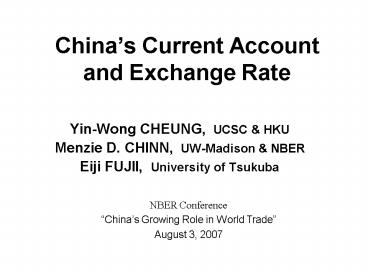Chinas Current Account and Exchange Rate - PowerPoint PPT Presentation
Title:
Chinas Current Account and Exchange Rate
Description:
... Current Account and Exchange Rate. Yin-Wong CHEUNG, ... This yields more intuitive estimates for the exchange rate elasticity ... CNY/USD Real Exchange Rate ... – PowerPoint PPT presentation
Number of Views:75
Avg rating:3.0/5.0
Title: Chinas Current Account and Exchange Rate
1
Chinas Current Account and Exchange Rate
- Yin-Wong CHEUNG, UCSC HKU
- Menzie D. CHINN, UW-Madison NBER
- Eiji FUJII, University of Tsukuba
NBER Conference Chinas Growing Role in World
Trade August 3, 2007
2
Chinas Current Account
Source IMF, World Economic Outlook April 2007
database
3
The Value of CNY
Source IMF, International Financial Statistics,
authors calculations
4
Trade Balance and Forex Reserves
Source IMF, International Financial Statistics
5
Outline
- An analysis of the CNY misalignment issue using
the standard deviations-from-Absolute PPP
approach - Highlighting the tension between economic and
statistical significance - Closer look at elasticities from a macro
perspective - The importance of uncertainty arises again
- Exchange rate is important but not central
6
Evaluating the Exchange Rate
7
Exploiting the Penn Effect
- Data from World Development Indicators, 1971-2005
- Vintages of WDI matter (the China path is
substantially different than our previous paper) - The r is in PPP terms, the y in USD, PPP terms
8
The Penn Effect Estimated
9
The Penn Effect Illustrated (I)
10
The Penn Effect Illustrated (II)
11
Observations
- The 2005 CNY is about 1.5 standard errors from
conditional mean, so statistically not misaligned - But the point estimate indicates a 50 (!)
undervaluation (in log terms) - If one changes the definition of undervaluation
as (e.g.) 3 consecutive years of misalignment,
not much changes since ? 0.95
12
Investigating Chinas Trade Elasticities
13
Multilateral Trade Elasticities
- Standard static imperfect substitutes approach.
- Analysis conducted on quarterly frequency, over
1993-06 period. - Sample period largely dictated by data
availability (changes in data collection). - y, y are real GDP, q is CPI deflated, z is
supply variable, w additional demand factor
14
Chinese Exports
15
Two (Recurring) Problems
- Chinese export data dont match rest-of-world
import data, vice versa - No Chinese deflators, pre-2005
- We rely on the Chinese data for multilateral
exports, imports - We try various proxies as deflators
16
Proxies for Export Deflators
17
(No Transcript)
18
(No Transcript)
19
Observations
- Holding z constant results in really high income
elasticity estimates, wrong sign on exchange
rate. - For aggregate exports, only z matters.
- For ordinary exports, income is insignificant,
while others come in significantly - Processing and parts exports fit quite well
- All results sensitive to inclusion of trend
20
Chinese Imports
21
Proxies for Import Deflators
22
(No Transcript)
23
Some Observations
- Aggregate, ordinary imports have wrong signed
price elasticities - Processing and parts imports only slightly better
behaved
24
Alternative Import Specification
- Since others have suggested a link between parts
imports and exports, we include total exports, w - This yields more intuitive estimates for the
exchange rate elasticity
25
Implications for Policy (I)
- Multilateral basis, 10 appreciation leads to
- A decline of imports by 70 bn
- A rise in the TB of 15 bn
- Zeroing out the perverse elasticity leads to a
decline in the TB of 46 bn - 2006 TB was 956 bn (2000)
- ( lt 86 bn in Marquez-Schindler)
- A decline of exports by 25 bn (2000)
26
Bilateral Trade Elasticities
- The standard equation augmented with a trade
weighted ex-U.S. real exchange rate variable - The q is now CNY/USD (CPI deflated)
- We examine both Chinese and US measures of
China-US trade
27
Chinese Exports to U.S.
28
What Accounts for the Differences?
- For Chinese exports, Chinese record as f.o.b., US
reports as c.i.f. - Chinese goods transiting HK might or might not be
correctly attributed to China - Value added in HK might be improperly attributed
to China - (see e.g., Schindler and Beckett, 2006)
29
Proxies for Chinese-U.S. Export Deflators
30
CNY/USD Real Exchange Rate
Note Adjusted indicates nominal exchange rate
takes into account transactions taking place at
floating rate.
31
Chinese Bilateral Export Elasticities
32
Chinese Imports from U.S.
33
Proxies for Chinese-U.S. Import Deflators
34
Chinese Bilateral Import Elasticities
35
Implications for Policy (II)
- A 10 real appreciation of CNY/USD results in
- 33 bn (2000) reduction in trade balance
- The 2006 China-US trade balance was 229 bn (2000)
- No necessary implication for overall US trade
deficit
36
Next Tasks
- Formal calculation of misalignment probabilities
- Checking for sensitivity to additional regressors
- Alternative measures of rest-of-world GDP (export
weighted GDP, world imports)































